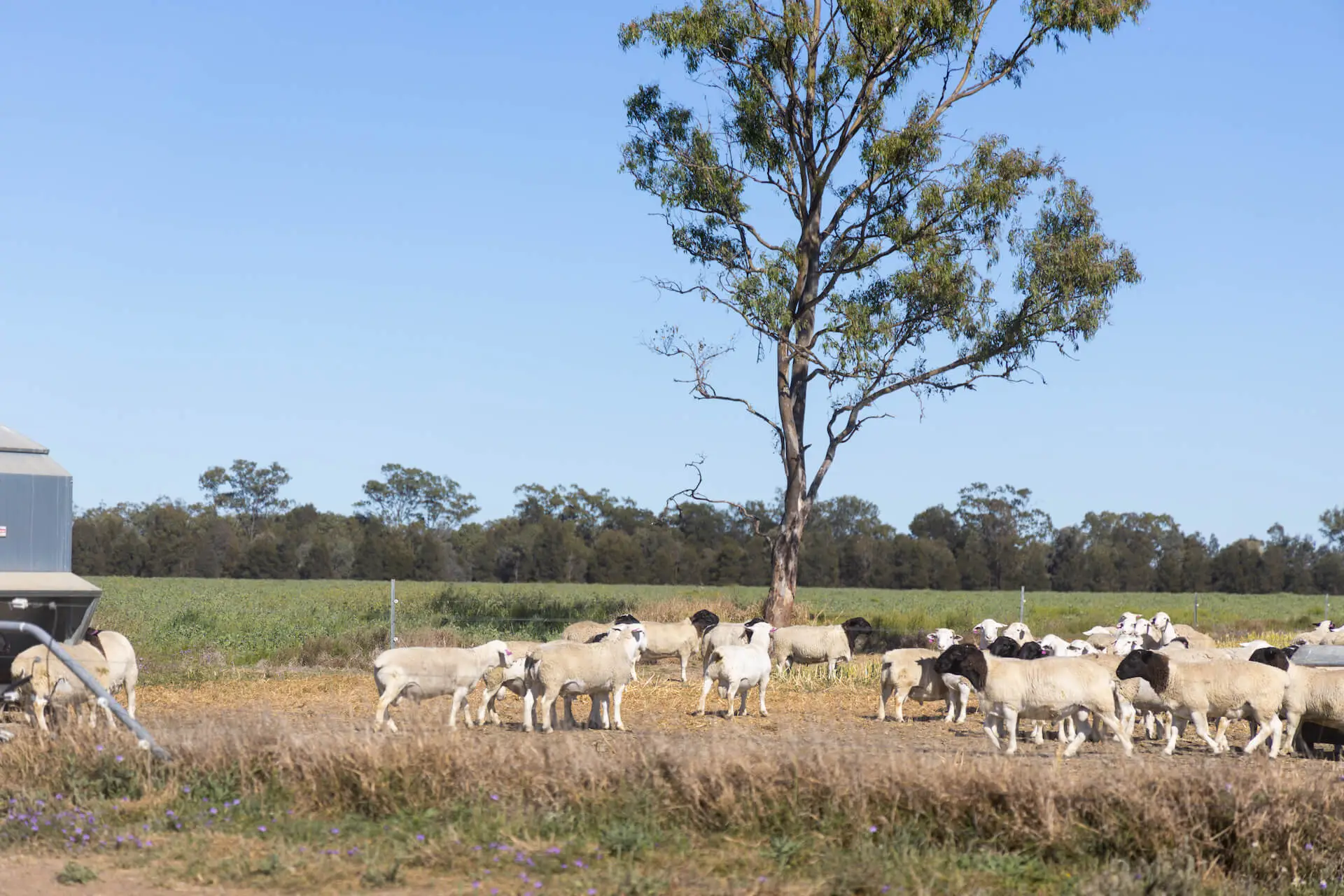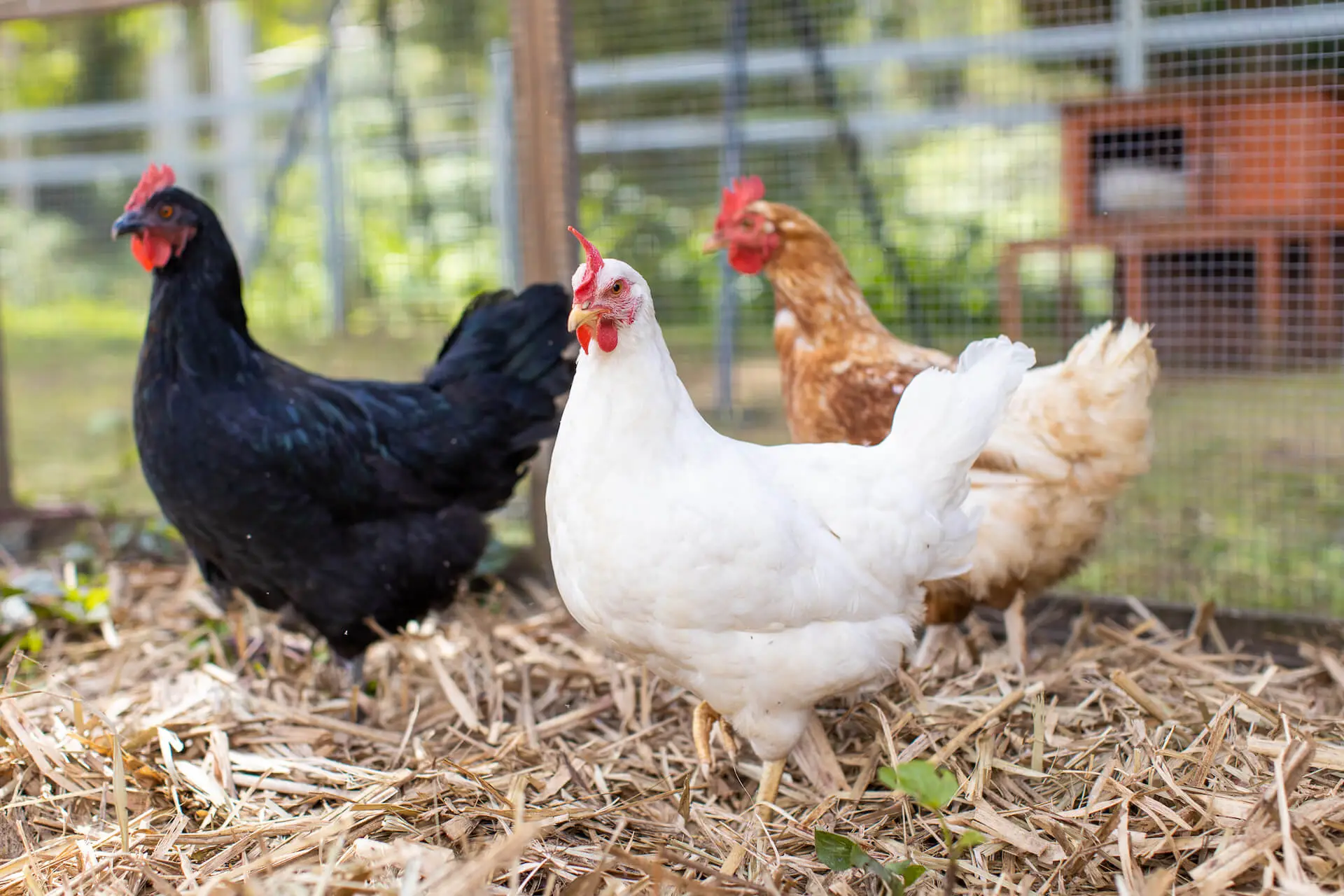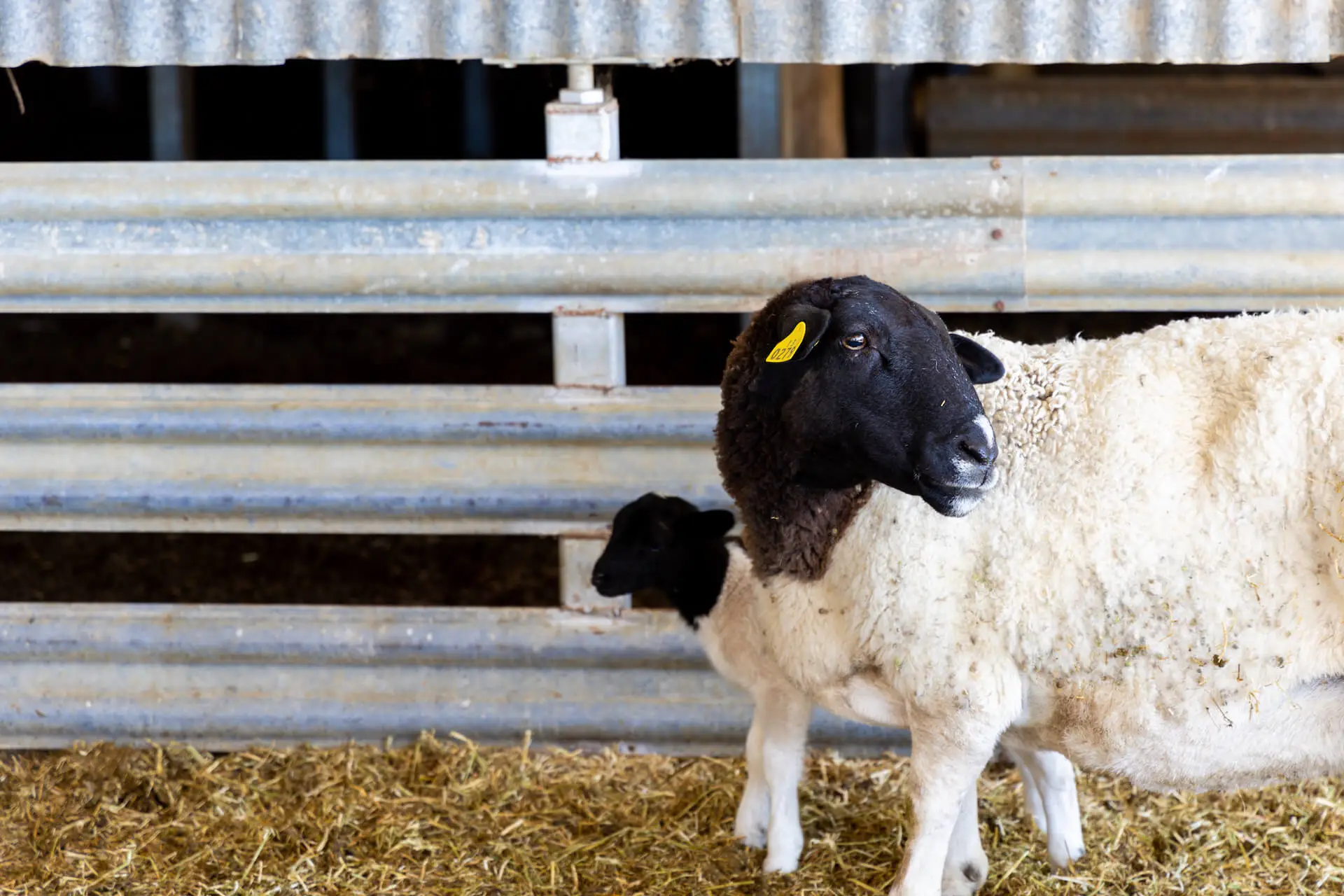Organic farming is an ecological management system that maintains and enhances soil fertility, promotes ecological balance, animal health and conserves biodiversity. The land and pasture on which organic livestock are raised must be certified organic and meet all organic crop production standards. No synthetic chemicals, pesticides, fertilisers or Genetically Modified Organisms (GMOs) are allowed on the land or within production, including in animal feed. Organic livestock must be fed 100 per cent certified organic feed, with an exception for trace minerals and vitamins sometimes required to meet the animal’s nutritional requirements. Organic livestock feed must not contain hormonal growth promotants (HGPs), antibiotics, preservatives, or synthetic chemicals.
The price difference between organic and non-organic meat remains a barrier to many consumers. However, there are several notable benefits to organic that justify this higher price point.

Animal Welfare
Animal welfare is one of the main reasons why consumers choose certified organic products. Arguably, animal welfare has decreased alongside the rise in meat consumption by humans, which can only be sustained through intensive farming practices. The Australian Certified Organic Standard (ACOS) is one of few food standards that addresses the welfare of all animals involved in organic food and fibre production. Under organic standards, animals including poultry, pigs, sheep, goats and cattle must live, grow and breed naturally in group sizes appropriate to their species, with more space to roam compared to their non-organic counterparts.
Battery farming or cage farming of hens is prohibited under organic production. Organic poultry have access to pasture and are fed organic grain mixes to complement production. They interact as they would in nature, and are provided with ample access to pasture, shade, and shelter. Beak trimming is not allowed within organic standards but is also less of a requirement with lower stocking densities in all types of production as seen in Table 1 below. The lower stocking density may result in fewer issues with hens fighting or competing for resources.
| Certified Organic: Set Stocking | Certified Organic: Rotational Stocking | Free Range | Caged | |
| Maximum number of egg laying birds per hectare | 1,500 | 2,500 | 10,000 | 180,000[1] |
| Maximum number of meat birds per hectare | 2,500 | 2,800 | 140,000[2] | – |
Organic standards encourage poultry breeds that are slower growing, more robust, and that can support their own body weight. Some non-organic poultry grow unnaturally fast due to the added hormones and growth promotants in their diet. This can result in the animals being unable to walk and considered lame. This practice is commonplace and accepted within some non-organic farms. Organic poultry is, by requirement, slow growing, meaning they live twice as long as most intensively farmed poultry, resulting in tastier and better-quality meat.

Pigs
The feed lotting of pigs is not allowed in organic production. Instead, organic pigs are kept under conditions that allow them to express their natural behaviour as much as possible. This includes natural farrowing practices, being kept in family groups and provided continued access to pasture.
Approximately 88 per cent of pigs are tail docked (where tails are cut short) in Australia. This practice is prohibited within organic systems[3]. Tail docking in pigs is solely to prevent bored and unhappy pigs (usually confined to sheds) from biting the tails of other pigs. Sow stalls are also used for this purpose; arcane and cruel constructions that are usually 2m long and 60cm wide. Female pigs can spend a large part of their 16-week pregnancy in sow stalls, where the pigs cannot even turn around or walk within the confines. The Australian pig industry has committed to phasing out the use of sow stalls, however, they are still used in at least 20 per cent of farms.
Intensive animal production has also led to the increased use of farrowing crates within non-organic systems. Farrowing crates are small metal enclosures only inches larger than the female pigs they house. Farrowing crates separate the sow from her piglets, reducing the risk of crushing the piglets. The sows remain here until the litter is weaned. Farrowing crates are prohibited in organic production, as they prevent sows from moving freely and hamper their ability to perform natural, maternal behaviour[4]. Organic pigs are not allowed in enclosed confined spaces and must always have free range access.
Cattle
Did you know 80 per cent of the beef you buy in Australian supermarkets is finished in a feed lot[5]? Certified organic production does not allow cattle feedlots. When consumers buy meat or animal by-products that are certified organic, they are ensuring that the animals have been raised under some of the most stringent welfare protection requirements in the world. Organic cattle have access to healthy pasture their whole lives. Grazing contributes to a healthy grassland ecosystem while feedlots cause vast dead zones from excess nutrients. Feed-lotting animals is also typically accompanied with increased antibiotic or hormone growth promotants (HGP) use[6]. Low (or ‘subtherapeutic’) concentrations of antibiotics in feed have been shown to increase livestock growth by 10-20 per cent; however, they can also promote antibiotic resistance, leave residue in meat[7], and may not be economically profitable for the farmer[8] .In addition to this, animals in feedlots are consuming grain that could be for human consumption.

Environmental Benefits
The Commonwealth Scientific and Industrial Research Organisation (CSIRO) recently conducted a study into the benefits of grass-based production systems. They found grass fed systems produce almost 1,600 times the amount of human edible protein they consume during their lifetime. This was 1,598 times more than non-organic grain fed beef systems (feedlots)[9].
As part of parasite control, organic animals need to be moved regularly as a form of natural preventative. This is often considered a regenerative grazing system where animals are moved often, and pasture isn’t overgrazed to the point of leaving bare ground. This in turn can reduce soil temperature, reduce soil erosion, increase water retention and contribute to carbon sequestration through organic matter increases in soil.
Greenhouse gas emissions may be similar for red meat (organic vs non-organic) as the mixture of feed lotting, HGPs and low dose antibiotics finish cattle faster (culled at a younger age) compared to grass fed and grazed cattle that roam freely. 40 per cent of Australian cattle are treated with Hormonal Growth Promotants (HGPs)[10]. HGPs can be added to feed or through an implant behind the ear of the cattle. HGPs increase the rate at which livestock muscle grows by about 10-30 per cent[11]. Through increased growth, the animals reach slaughter weight faster, however it results in leaner animals with tougher meat and muted flavour[12]. However, 90 per cent of these compounds (and antibiotics) are excreted in unchanged form from the animals and may enter the water sources or slowly build up within the environment. Even in minimal concentrations, this can cause reproductive problems in wildlife[13][14].
Animal Health Benefits
Organic farmers are not permitted to routinely use drugs (antibiotics, anthelmintics, etc.) to prevent diseases and parasites; rather, they rely on keeping animals in optimal health. This is achieved through geographical selection, animal selection, and farming management practices that are ideal for the animal. In simple terms, organic farmers breed animals that are suited to the climate in which they are farmed.
GMOs are not allowed within organic animal production. There are many animal studies linking GM crops with wide-ranging negative effects on organs, reproductive systems, induced blood, hormonal and immunological alterations, toxicity in multiple organs as well as increased tumours and mortality[15][16][17][18]. Many studies show signs of toxicity in the liver and kidney of the animals fed GM crops. As the major detoxifying organs, these are often the first to show evidence of chronic disease[19], however these effects are often disregarded as biologically insignificant when they don’t cause animal mortality. In addition to the potential toxic effects of GMO components, changes in farming practices linked to the use of GMOs may result in even higher toxic residues. For example, higher levels of crop contamination with the herbicide glyphosate are an inevitable result of using genetically modified crops that tolerate glyphosate[20].
Human Health Benefits
If the animal welfare, environmental and ethical arguments weren’t enough, organic meat also has numerous nutritional benefits. Animals that are allowed to graze on pasture have consistently higher polyunsaturated fat, omega-3s and other nutrients in their meat compared to feed-lotted animals[21].
Within non-organic agriculture, antibiotics are often permitted for treating or preventing diseases which routinely occur due to poor husbandry practices, particularly in intensive farming systems. Currently, over 75 per cent of the world’s antibiotic use is for livestock production[22]. Antibiotics are given both as treatment for infections and in low concentrations as a growth promotant. The World Health Organisation’s (WHO) report on ‘The medical impact of antimicrobial use in Food Animals’[23] highlighted several cases where transfer of resistance from animals to humans had occurred. Over 700,000 people die annually from antibiotic resistant bacteria. This transfer of resistance is largely attributed to antibiotic residues in non-organic meat and milk[24]. By the year 2050, researchers predict that antibiotic resistance will cause 10 million deaths every year, surpassing cancer as the leading cause of mortality worldwide[25]. Even though Australia routinely monitors antibiotic use, antibiotic residues are still found in Australian meat[26]. Europe has banned the use of HGPs within livestock due to their associations with increased cancer risk[27]. As soon as an animal is treated with antibiotics or HGPs, it may never be sold as certified organic meat. Read our Health Benefits of Organic article for more details.

Price Differentiation
Organics is a holistic means of growing and handling the products we consume. The Australian Organic Market Report 2021 found that price remains the number one reason why people refrain from buying organic products[28]. The increased price you pay for organics is due to a multitude of factors.
Firstly, organic producers are required to pay additional certification and audit fees to show that they conform to stringent organic standards. It is not only producers that have to be verified. Processors, handlers, wholesalers and the whole chain, from the farm soil to the steak on your plate, are all certified to these standards. Certified organic producers are audited annually to ensure they are maintaining the requirements of their certification. Additional unannounced inspections are also undertaken on random or targeted operations throughout the year.
Within organic production, animals require larger areas of land per animal. In addition to this, any supplementary feed must also be certified organic, which can also be more expensive compared to non-organic. Organic animal feed may be more expensive due to lower yielding non-GMO varieties, weed pressure or the flow-on certification costs for organic crop production.
Given organic animals are not allowed to be treated with HGPs or subtherapeutic doses of antibiotics, they grow slower than non-organic livestock. This means they are typically older at slaughter and therefore, may cost more to produce.
Organic slaughter systems use an air chilling system, where the chickens lose 2 per cent or more of their bodyweight cooling down (post slaughter) while non-organic farms use chlorinated ice baths. This can add 9 per cent of body weight that the consumer then pays for. Similar systems are used with red meat packaging, resulting in consumers effectively paying for water weight instead of the meat itself.
A culmination of all these factors results in the price differentiation observed for organic meat products. The question is, what price can you pay for your health?
Conclusion
Organic livestock farming doesn’t come without its complications. Reaching a good stocking balance, the right genetics and correct agricultural management in an often-harsh Australian climate can be challenging. However, organic farmers are putting in this work every day to provide you with healthy, sustainable meat free from artificial hormones, synthetic fertilisers, antibiotics and GMOs.
[1] Australian Eggs. (2022). What Are Cage Eggs? Available at: https://www.australianeggs.org.au/farming/cage-eggs.
[2] Barnett, J.L., Edge, M.E., Thomson, L., Mackenzie, M., Sansom, G. Kite, V., 2008. National Welfare standard for Chicken Meat. Available from: www.chicken.org.au.
[3] Morrison, R., & Hemsworth, P. (2020). Tail Docking of Piglets 2: Effects of Meloxicam on the Stress Response to Tail Docking. Animals : an open access journal from MDPI, 10(9), 1701. https://doi.org/10.3390/ani10091701.
[4] RSPCA Knowledge Base. (2021). What are the animal welfare issues with sow stalls and farrowing crates? Available at: https://kb.rspca.org.au/knowledge-base/what-are-the-animal-welfare-issues-with-sow-stalls-and-farrowing-crates/.
[5] Future Beef. (2018) Feedlots. Available at: https://futurebeef.com.au/knowledge-centre/feedlots/#:~:text=Approximately%
2040%25%20of%20Australia’s%20total,
to%20over%20100%20international%20market.
[6] Gaughan JB, Kreikemeier WM, Mader TL (2005) Hormonal growth-promotant effects on grain-fed cattle under different environments. International Journal of Biometeorology 49, 396–402. doi:10.1007/s00484-005-0254-6Gorman
[7] World Health Organisation (2018). Antimicrobial resistance in the food chain. [Fact Sheet] Retrieved from: https://www.who.int/foodsafety/areas_work/
antimicrobial-resistance/amrfoodchain/en/.
[8] Graham, J. P., Boland, J. J., & Silbergeld, E. (2007). Growth promoting antibiotics in food animal production: an economic analysis. Public health reports (Washington, D.C. : 1974), 122(1), 79–87. https://doi.org/10.1177/003335490712200111.
[9] Tyers, P. (2021) CSIRO sets beef benchmark for protein production. CSIRO. Available at: https://www.csiro.au/en/news/news-releases/2021/csiro-sets-beef-benchmark-for-protein-production.
[10] Lu, D. (2021). Nearly half of Australia’s cattle is treated with growth hormones. Is it safe to eat? The Guardian. Available at: https://www.theguardian.com/food/2021/jun/06/nearly-half-of-australias-cattle-is-treated-with-growth-hormones-is-it-safe-to-eat.
[11] Hunter A (2010) Hormonal growth promotant use in the Australian beef industry. Animal Production Science 50, 637–659. doi:10.1071/AN09120Kastner.
[12] Watson RA (2008) Meta-analysis of the published effects of HGP use on beef palatability in steers as measured by objective and sensory testing. Australian Journal of Experimental Agriculture, https://www.publish.csiro.au/an/pdf/EA07174.
[13] Orlando, E. O.; Kolok, A. S.; Binzcik, G. A.; Gates, J. L.; Horton, M. K.; Lambright, C. S.; Gray, J., L. E.; Soto, A. M.; Guillette, J., L. J. Endocrine disrupting effects of cattle feedlot effluent on an aquatic sentinel species, the fathead minnow. Environ. Health Perspect. 2004, 112, 353−358.
[14] Kidd, K. A.; Blachfield, P. J.; Mills, K. H.; Palace, V. P.; Evans, R. E.; Lazorchak, J. M.; Flick, R. W. Collapse of a fish population after exposure to a synthetic estrogen. Proc. Natl. Acad. Sci. U.S.A. 2007, 104, 8897−8901.
[15] Dona A, Arvanitoyannis IS. Health risks of genetically modified foods. Crit Rev Food Sci Nutr. 2009;49:164–75. doi:10.1080/10408390701855993.
[16] Pusztai A. Can science give us the tools for recognizing possible health risks of GM food? Nutr Health. 2002;16:73-84.
[17] Hines FA. Memorandum to Linda Kahl on the Flavr Savr tomato (Pathology Review PR–152; FDA Number FMF– 000526): Pathology Branch’s evaluation of rats with stomach lesions from three four-week oral (gavage) toxicity studies (IRDC Study Nos. 677–002, 677–004, and 677–005) and an Expert Panel’s report. US Department of Health &Human Services; 1993. Available at: http://www.biointegrity.org/FDAdocs/17/view1.html.
[18] Fagan, J., Antoniou, M., Robinson, C., 2014. GMO Myths and Truths. Earth Open Source. Available at: http://livingnongmo.org/wp-content/uploads/2014/11/GMO-Myths-and-Truths-edition2.pdf.
[19] Séralini GE, de Vendomois JS, Cellier D, et al. How subchronic and chronic health effects can be neglected for GMOs, pesticides or chemicals. Int J Biol Sci. 2009;5:438-43.
[20] Séralini GE, Clair E, Mesnage R, et al. [RETRACTED:] Long term toxicity of a Roundup herbicide and a Roundup tolerant genetically modified maize. Food Chem Toxicol. 2012;50:4221-4231.
[21] Chang, Kenneth. “Organic Meat and Milk Higher in Healthful Fatty Acids.” The New York Times. Available at: http://well. blogs. nytimes. com/2016/02/15/more-omega-3-in-organic-meat-and-milkreview-of-studies-says (2016).
[22] Van Boeckel, T.P., Glennon, E.E., Chen, D., Gilbert, M., Robinson, T.P., Grenfell, B.T., Levin, S.A., Bonhoeffer, S. and Laxminarayan, R., 2017. Reducing antimicrobial use in food animals. Science, 357(6358), pp.1350-1352.
[23] World Health Organization. The Medical impact of the use of antimicrobials in food animals: report of a WHO meeting, Berlin, Germany, 13-17 October 1997. No. WHO/EMC/ZOO/97.4. World Health Organization, 1997.
[24] Animals Australia. (2020.) WATCH: A Deep Dive into Antibiotic Resistance. Available at: https://animalsaustralia.org/latest-news/deep-dive-antibiotics/.
[25] Sandoiu, A. (2018). Drug resistance: Does antibiotic use in animals affect human health? Medical News Today. Available at: https://www.medicalnewstoday.com/articles/323639.
[26] Australian Government Department of Agriculture, Water and the Environment. (2020). Beef residue testing annual datasets 2020–21. Available at: https://www.awe.gov.au/sites/default/files/
documents/beef-residue-testing-datasets-2020-21.pdf
[27] Save Our Antibiotics. (2020). Farm Antibiotics and Trade. Available at: https://www.saveourantibiotics.org/media/1864/farm-antibiotics-and-trade-could-uk-standards-be-undermined-asoa-nov-2020.pdf.
[28] The University of Melbourne, Euromonitor International, Mobium Group, NielsenIQ, Australian Organic Market Report 2021 (Australian Organic Limited, 2021).